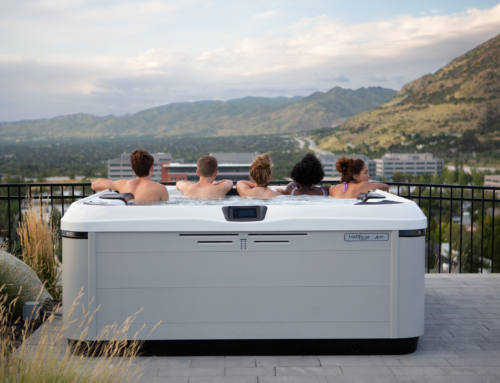Blogging doesn’t have to suck…or be a huge time sucker. Even for a busy spa dealer.
According to HubSpot, B2C companies who blog get 88% more leads. And 60% of businesses who blog acquire more customers than those who don’t. Why?
60% of businesses who blog acquire more customers than those who don’t.
A business blog:
- Improves SEO and drives site traffic
- Builds customer relationships and develops a level of trust
- Establishes expertise and industry authority
- Personalizes the brand by giving it a voice
Blogging provides value through content in order to build an online audience that is engaged with your brand. And by engaged, I mean in conversation with—which is different than being sold to. The rest of your website is where you describe who you are, what you do best, and the products you sell. Your blog is where you build connection and rapport over a common area of interest with consumers.
What to Blog?
One of the leading gurus in content marketing today is Marcus Sheridan, co-owner of River Pools. Sheridan is well known for taking his inground fiberglass swimming pool company through the 2008 recession by applying an online content strategy that landed his site as the top-performing pool website in the world.
In case you haven’t read the River Pools case study, here’s an excerpt from an interview with Marcus Sheridan reported by copyblogger.com describing their efforts.
“I started River Pools with two partners in 2001, and when the housing market collapsed in 2008, we were in big trouble. That’s when we discovered content marketing and decided to be the best teachers in the world about our business…This decision saved our company.
I realized early on that the golden rule of content marketing is simple: ‘They Ask, You Answer.’
My philosophy is that if anyone has asked me a question about my business, regardless of what it is, it’s my job to answer that question—preferably on my website. This philosophy is what made River Pools so incredibly successful….”
To take a page from Sheridan’s book, your website’s FAQ section is a good place to start generating topic ideas.
How to Blog?
For a layman’s explanation of how to blog, H2Insider asked seasoned pro Jake Ricks of Bullfrog Spas to break the how-to down for us. As Digital Marketing Manager, Ricks fields spa retailers’ questions about online content almost daily. So he’s used to explaining the process in a simple and straightforward way. Here’s what Ricks suggests.
- Add blog to your website. Your blog should live within your domain to make the most of SEO advantages. For example, Mike’s Hot Tubs url of mikeshottubs.com would have its blog live at mikeshottubs.com/blog. Ricks recommends using the WordPress platform to set your blog up, but other platforms like HubSpot and Squarespace work as well. WordPress tools allow you to add a blog to either a new or existing website.
- Create an editorial calendar. One of my favorite bulletin board pins is a blank postcard that says, “I plan, therefore I am.” On the back, workflow tool provider DivvyHQ declares that “the best content starts with a great plan.” So map out your topics on a calendar to ensure topic balance and structure to your posting schedule. Consistency is key to fueling Google search results. That said, quality preempts quantity at the end of the day.
- Write the right headline. When writing a headline, it’s important to consider how consumers are searching for the information you’re providing. You want the phrasing to match the user’s question or concern as closely as possible. And people search the way they talk. If they want to know how to winterize their hot tub, the blog post should be titled “How to Winterize a Hot Tub” or “How Do I Winterize a Hot Tub?”
- Add images. Every blog post should have at least one image. Imagery creates visual appeal and can communicate a message sometimes even more effectively than words. Images can also improve SEO efforts with alt-text and descriptions that factor into the equation. Make sure to resize and compress images when uploading. And always get permission and include image or photo credits.
- Include links. SEO experts at Moz put it best: “For search engines that crawl the vast metropolis of the web, links are the streets between pages.” Search engines use links to evaluate site popularity and trustworthiness. That means it’s worth your while to include links in your blog to other internal posts and web pages. In addition to other external content you’re sourcing, of course.
- Promote your blog. Start by including links to your blog on all of your social media profiles. Then share snippets of blog content on these platforms and let others spread the word about your brand. Whether it’s scheduling posts on Facebook or creating new boards in Pinterest, social media enables your blog to attract new readers while providing more value for existing followers.
So are you ready to drive business with your blog? Leverage credibility and watch as your prospects improve and revenues rise. Here’s H2Insider’s recommended list of blog post topics tailored specifically for hot tub retailers to help you get started.
Blog Topics for Spa Businesses
| PricingMaintenance
Water care Energy use Spa operation Installation requirements |
Accessories
Parts Winterizing Best filtration system Mechanical sanitation Chemical safety |
Salt water systems
Local events Quality family time Health benefits Backyard design Deck plans |
When the well runs dry, dig a little deeper. Ricks loves to point out that “Can hot tubs cause rash?” and “Can a dog use hot tub?” are two of his most popular posts. Gross? Maybe. But they continue to get results over time. Just remember: they ask, you answer.









Leave A Comment